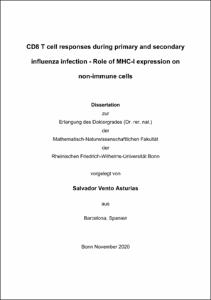Vento Asturias, Salvador: CD8 T cell responses during primary and secondary influenza infection - Role of MHC-I expression on non-immune cells. - Bonn, 2021. - Dissertation, Rheinische Friedrich-Wilhelms-Universität Bonn.
Online-Ausgabe in bonndoc: https://nbn-resolving.org/urn:nbn:de:hbz:5-63084
Online-Ausgabe in bonndoc: https://nbn-resolving.org/urn:nbn:de:hbz:5-63084
@phdthesis{handle:20.500.11811/9292,
urn: https://nbn-resolving.org/urn:nbn:de:hbz:5-63084,
author = {{Salvador Vento Asturias}},
title = {CD8 T cell responses during primary and secondary influenza infection - Role of MHC-I expression on non-immune cells},
school = {Rheinische Friedrich-Wilhelms-Universität Bonn},
year = 2021,
month = sep,
note = {Influenza infection results in strong immune responses in the lung usually leading to clearance of infection and, in some cases, immune pathology with varying degrees of prognosis. CD8 T cells are believed to be one of the key players to resolve primary and secondary viral infections by directly eliminating infected cells. During this study I aimed at elucidating how CD8 T cells infiltrate the infected lung and contribute to the clearance of viral infection. With an initial focus on acute influenza infections, I devised a novel flow cytometric method, which I termed IDEAL, to accurately analyze immune cell positioning in the lung via flow cytometry, and used it to identify CTL differences at a genomic, function and migration levels depending on their anatomical location. Despite identifying minor transcriptomic differences between CTLs present in the interstitial and bronchoalveolar compartments, they did not effectively translate into functional differences regarding their cytotoxic capacity or ability to home to a specific lung compartment. Furthermore, using CD8 T cell depletion protocols and adoptive transfers of flu-specific effector CTLs into naïve mice prior or during infection, I found CD8 T cells to be dispensable during acute influenza infection but pivotal to a quick and efficient recovery following a secondary challenge with a heterotypic flu strain. I then continued to investigate how memory CD8 T cells conferred protection against a secondary influenza challenge by studying the necessity of MHC-I/peptide-TCR interactions between infected epithelial cells and CD8 T cells by means of bone marrow chimeras. Influenza-specific CD8 T cells conferred significantly better protection when TCR recognition of infected epithelium was prevented. Furthermore, I studied the importance of dendritic cells in the re-activation of memory CD8 T cells and could show how DCs are key for effector CD8 T cell function and viral clearance. In summary, the results presented here show that (1) CD8 T cells located at different pulmonary compartments have apparently similar phenotype and function within the infected lung, (2) they are, however, dispensable to overcome acute influenza infections but (3) are key during a secondary flu challenge. Finally, (4) during secondary infection I have proven how killing of epithelial cells is rather detrimental for recovery from infection and how memory CD8 T cells require DCs to confer protection.},
url = {https://hdl.handle.net/20.500.11811/9292}
}
urn: https://nbn-resolving.org/urn:nbn:de:hbz:5-63084,
author = {{Salvador Vento Asturias}},
title = {CD8 T cell responses during primary and secondary influenza infection - Role of MHC-I expression on non-immune cells},
school = {Rheinische Friedrich-Wilhelms-Universität Bonn},
year = 2021,
month = sep,
note = {Influenza infection results in strong immune responses in the lung usually leading to clearance of infection and, in some cases, immune pathology with varying degrees of prognosis. CD8 T cells are believed to be one of the key players to resolve primary and secondary viral infections by directly eliminating infected cells. During this study I aimed at elucidating how CD8 T cells infiltrate the infected lung and contribute to the clearance of viral infection. With an initial focus on acute influenza infections, I devised a novel flow cytometric method, which I termed IDEAL, to accurately analyze immune cell positioning in the lung via flow cytometry, and used it to identify CTL differences at a genomic, function and migration levels depending on their anatomical location. Despite identifying minor transcriptomic differences between CTLs present in the interstitial and bronchoalveolar compartments, they did not effectively translate into functional differences regarding their cytotoxic capacity or ability to home to a specific lung compartment. Furthermore, using CD8 T cell depletion protocols and adoptive transfers of flu-specific effector CTLs into naïve mice prior or during infection, I found CD8 T cells to be dispensable during acute influenza infection but pivotal to a quick and efficient recovery following a secondary challenge with a heterotypic flu strain. I then continued to investigate how memory CD8 T cells conferred protection against a secondary influenza challenge by studying the necessity of MHC-I/peptide-TCR interactions between infected epithelial cells and CD8 T cells by means of bone marrow chimeras. Influenza-specific CD8 T cells conferred significantly better protection when TCR recognition of infected epithelium was prevented. Furthermore, I studied the importance of dendritic cells in the re-activation of memory CD8 T cells and could show how DCs are key for effector CD8 T cell function and viral clearance. In summary, the results presented here show that (1) CD8 T cells located at different pulmonary compartments have apparently similar phenotype and function within the infected lung, (2) they are, however, dispensable to overcome acute influenza infections but (3) are key during a secondary flu challenge. Finally, (4) during secondary infection I have proven how killing of epithelial cells is rather detrimental for recovery from infection and how memory CD8 T cells require DCs to confer protection.},
url = {https://hdl.handle.net/20.500.11811/9292}
}






